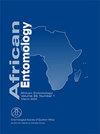Distribution and impact of the native South African wasp, Megastigmus transvaalensis (Hussey, 1956) (Hymenoptera: Torymidae) on the invasive Schinus terebinthifolia Raddi (Anacardiaceae) in South Africa
IF 1.2
4区 农林科学
Q3 ENTOMOLOGY
引用次数: 0
Abstract
Schinus terebinthifolia Raddi (Anacardiaceae) (Brazilian pepper tree) is a tree native to subtropical South America that was introduced into South Africa as an ornamental plant. Globally, it is regarded as one of the world’s worst invasive trees. In South Africa the tree has acquired a native seed-feeding wasp, Megastigmus transvaalensis (Hussey, 1956) (Hymenoptera: Torymidae). The wasp’s native hosts are from the Searsia F.A. Barkley genus (Anacardiaceae), but it has expanded its host range to form a new association with both S. terebinthifolia and its close relative Schinus molle L. (Anacardiaceae). In order to quantify the seed predation by M. transvaalensis on S. terebinthifolia seeds, tree populations were surveyed across the Eastern Cape and KwaZulu-Natal provinces. The wasp was present at 99% of the S. terebinthifolia populations with an average of 22% of the seeds being destroyed. In the Eastern Cape province, the highest seed damage occurred at the start of the winter months, when about 35% of seeds were damaged. This fell to less than 12% in spring and summer when the plants were flowering. Megastigmus transvaalensis was found at nearly all the S. terebinthifolia populations in South Africa, but due to the limited number of predated seeds it is unlikely to reduce population sizes or curb the spread of the invasive alien tree in South Africa.南非本土黄蜂Megastimus transvalensis(Hussey,1956)(膜翅目:Torymidae)在南非的分布和对入侵的圆叶Schinus terebinthifolia Raddi(Anacardiae)的影响
巴西胡椒树(Schinus terebinthifolia Raddi)是原产于南美洲亚热带的一种树木,作为观赏植物引入南非。在全球范围内,它被认为是世界上入侵最严重的树木之一。在南非,这棵树已经获得了一种以种子为食的本土黄蜂,跨花大柱头蜂(Hussey,1956)(膜翅目:Torymidae)。这种黄蜂的本地宿主来自Searsia F.A.Barkley属(Anacardiae),但它已经扩大了宿主范围,与s.terebinthifolia及其近亲Schinus molle L.(Anacardicae)形成了新的联系。为了量化M.transvalensis对S.terebinthifolia种子的捕食,对东开普省和夸祖鲁-纳塔尔省的树木种群进行了调查。这种黄蜂存在于99%的terebinthifolia种群中,平均22%的种子被破坏。在东开普省,种子受损程度最高的是在冬季开始的几个月,当时约35%的种子受损。在春季和夏季,当植物开花时,这一比例降至12%以下。在南非几乎所有的大角木种群中都发现了跨瓣大柱头菌,但由于被捕食的种子数量有限,这不太可能减少种群规模或遏制入侵外来树木在南非的传播。
本文章由计算机程序翻译,如有差异,请以英文原文为准。
求助全文
约1分钟内获得全文
求助全文
来源期刊

African Entomology
生物-昆虫学
CiteScore
2.00
自引率
0.00%
发文量
17
审稿时长
6-12 weeks
期刊介绍:
African Entomology (ISSN 1021-3589 – print / 2224-8854 – online) replaced the old Journal of the Entomological Society of Southern Africa in 1993. A single volume consisting of two issues (March and September) is published annually. The journal is indexed in all major abstracting journals
African Entomology is a peer reviewed scientific journal that publishes original research articles and short communications on all aspects of entomology, with an emphasis on the advancement of entomology on the African continent.
 求助内容:
求助内容: 应助结果提醒方式:
应助结果提醒方式:


